Full Length Research Paper
ABSTRACT
The detailed sedimentary study of the deposit sequences of the ancient hominid sector (SahelanthropustchadensisalisToumaï) of Toros-Menalla, presented here addresses new aspects of the sedimentary geology of the Chad Basin through an original field study of Moi-sediments: Pliocene of the northern basin of CHAD. This is an original contribution that sheds light on new knowledge of sedimentary series of fluvio-lacustrine and aeolian origin in the Djourab desert which are essential for understanding the paleoenvironments and paleoclimates of Chad, the Sahara and Africa. Aged from the Terminal Miocene to the present day, these deposits which constitute the last stages of the filling of this basin are exclusively of the continental type and concern in the broad sense the following four major sedimentary systems: Fluvial, deltaic, lacustrine and aeolian. From a lithological point of view, these sedimentary series are very heterogeneous and include sandstones, sands, clays and diatomites.
Key words: Sedimentary deposit, Djourab, Toros-Menalla, Chad, fluvio-lacustrine, Aeolian.
INTRODUCTION
In Africa and more particularly in the Chad Basin, the dynamics of paleoenvironments during the Mio-Pliocene played a crucial role in the history of the emergence and evolution of ancient hominids (Novello et al., 2015, 2017; Barboni et al., 2019; Bobe et al., 2020). Despite the importance of the Neogene and Quaternary continental sedimentary series present at the scale of the Chad basin, they are still poorly known and very little studied, in particular due to the absence of a robust chronological framework and especially their particular conditions: outcrops (Duval et al., 2021). The interpretation of the facies of these sedimentary series has so far not been the subject of specific studies, in particular because of poor outcrop conditions and the difficulty of correlating outcrops between them both in age and facies (Minisini et al., 2018).
A first contribution to the knowledge of the Cenozoic continental sedimentary formations of the Chad basin was made in the 1970s (Servant-Vildary, 1973) and was particularly interested in the paleoclimatic message of these series. Another more recent study (Schuster, 2002, Moussa et al., 2016) is more focused on the one hand on the paleoenvironments of the mio-pliocene series with ancient vertebrates and hominids of the Djourab erg and on the other hand on the major lacustrine episode of the Holocene embodied by Lake Mega-Chad (Bristow et al., 2018; Yu et al., 2020). But a real stratigraphic study and a sedimentological analysis of these sedimentary series are missing.
The objective of this work is to attempt to reconstruct the deposition environments of the Chad basin during the last 7 million years and to make the link between the arenitic facies of the edges of the lake and the clay facies in the center of the Chadian basin and to propose a typical stratigraphic sequence in this area.
Particular attention will be paid to the sedimentary environments of the hominid sites in the northern part of the basin. This part of the current desert Chadian basin has been systematically excavated since 1994 by the Franco-Tchadien Paleontological Mission (MPFT). Currently more than 400 fossiliferous sites have emerged, the oldest of which have yielded the oldest hominid known to date (Toumaï: Sahelanthropus tchadensis) (Brunet et al., 2002; Alemseged et al., 2020). The fossiliferous sites are dated jointly by biochronology (faunistic associations) and by radiometric dating (Be10) (Brunet et al., 1995, 1996, 1997; Vignaud et al., 2002; Lebatard et al., 2008; Branco Pavanotto et al., 2020) vary between 3.5 and 7.32 million years (Ma). All the fossil sites in northern Chad form a strip of outcrop, oriented east-west, covering an area of ??approximately 2,500km2. It constitutes a key zone which has played a role of oscillating buffer according to hydroclimatic fluctuations (Armitage et al., 2015; Bristow and Armitage 2016; Sewell, 2019).
The facies described range from lake to wind, passing through deltaic or peri-lacustrine margino-littoral facies.
This study is an original contribution to the knowledge of sedimentary series in the Chad basin. It brings new data for the understanding of paleoenvironments and paleoclimates of Chad, the Sahara and Africa from the late Miocene to the present.
METHODOLOGY
Study site
In northern Chad in the eastern part of the Djourab desert, the Toros-Menalla (TM) fossiliferous sector is the most important of those discovered by the MPFT. More than 300 sites have been prospected and analyzed. They are in an area between 16° 09 ' and 16° 17'N and 17° 28' and 18° 07 'E (Figure 1). The sites extend over approximately 200 km from east to west and 30 km from north to south. The fossiliferous sites and deposits of the Djourab desert (1) are defined as non “empty” outcrops (having yielded at least one fossil) separated from each other by sand dunes (Mackaye, 2001). The five fossil-bearing sectors of Djourab are: the Toros-Menalla (TM) sector, the Kossom-Bougoudi sector (KB), the Kollé sector (KL), the sector of Koro-Toro (KT) and finally the fossiliferous sector of the cliff of Angamma (ANG) (Mackaye, 2001). The outcrops are in large, flattened areas that denote the Miocene series. They are generally flat or very slightly wavy; the most important rarely exceed a few meters. The TM outcrops are located to the south of the lowest part of the Chadian basin called "Low Country" and whose altitude oscillates around 160 m. This depression in the northern Chadian basin is directly opposite a very active wind ravine in the Erdis basin, wedged between the Tibesti and Ennedi mountains. Locally, deflation can reach 2 to 3 cm per year. The TM zone is close to the Bodélé depression, well known to be the most important zone of wind power exploitation of Saharan sands and which leads to the denudation of the summit part of the Miocene (Warren et al., 2005). In the middle of this gigantic sea of ??sands and aeolian dunes, the outcrops of TM appear in the form of erosion windows. The deposits and facies of fossil outcrops have been described by Schuster (2002) and Moussa et al. (2016) who described the recurrence of an elemental desert-lake model as mainly sandy-detrital, sandy-clayey, and more rarely clayey or diatomite series. In the specific TM sector, the bottom of the trenches is made up of a sandy series characterized by large, inclined litters 10 m wide or more. It is interpreted as a major wind episode (Schuster, 2002; Schuster et al., 2006, 2009; Novello et al., 2015, 2017).
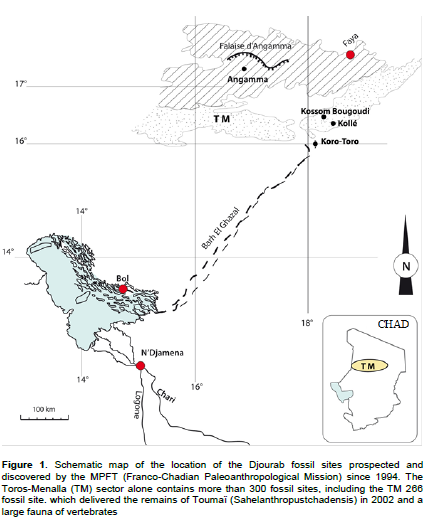
Cuts and outcrops
Several fossiliferous sites of Toros-Menalla (TM) including TM 266 have been the subject of precise cross-section surveys (Figure 2). The sections (or stratigraphic logs) have been correlated with each other over about 30 km showing the good lateral continuity of the large deposits on the scale of the meter. They also show rapid lateral variations at the scale of decimetric sequences as is usually the case in continental systems. The outcrops studied and the sections surveyed are in an area of 250 km² limited around the fossiliferous site of TM 266.
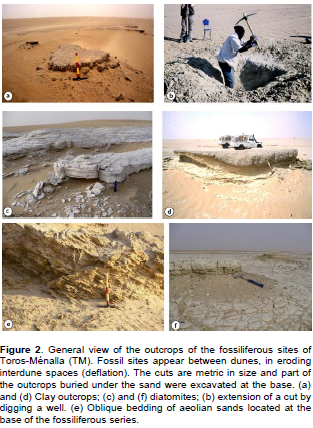
The approach adopted here is simple since it relies almost essentially on field observations and the interpretation of the large morpho-sedimentary structures characteristic of deposit environments described for the first time by Servant-Vildary (1973), Vignaud et al. (2002), Schuster (2002), Schuster et al. (2003) and Moussa et al. (2016); Bristow et al. (2018). The absence or even the weak vegetation cover and the good preservation of morpho-sedimentary structures prove to be an asset for the observations (Bianchini et al., 2019). A lot of terrain images were used to interpret the different facies. The sections were drawn on a computer using software such as Adobe Illustrator and Photoshop. Photo-interpretation of facies was of great use in this study.
On the ground, the outcrops of a few meters or the escarpments as in the quarries are rare and the ground is too flat, we have to carry out very difficult cuts on the witness ridges or to dig trenches to make the observations of the various deposits (Bianchini et al., 2019; Branco Pavanotto et al., 2020). The area of the Toros-Menella (TM) sites is close to the Bodélé depression (120 m), well known to be the most important wind farm in the Saharan sands and which leads to the denudation of the top part of the Miocene (Warren et al., 2005; Bristow et al., 2018).
RESULTS AND DISCUSSION
Main lithological units
Three main lithological units follow one another from thebase to the top of the sections (Vignaud et al., 2002; Moussa et al., 2016): (1) clear sands with large bundles of oblique bedding at the base (Basal aeolian unit), (2) sandy sandstones and weakly indurated clayey sandstones in the middle part (Anthracotheriid unit), and (3) green clays and diatomites in the upper part (Lacustrine unit). The typical profile (Figure 3) is a synthetic profile reconstructed using several sections taken at different locations in the TM 266 sector.
Light sands with large oblique bedding beams
The basal part of the profile (at least 2 m thick) is composed of light fine-grained to very fine sand, rarely cemented except in the highest parts. The quartz grainsare well sorted, rounded and dull. This unit is characterized by the presence of large bundles of oblique bedding (Figure 3). The roots only appear in the upper part of the profiles. This unit constitutes an excellent lithostratigraphic landmark because it is the only one presenting such beams of oblique bedding and the only truly sandy one. Also, there are never any fossils in this level.
Fossiliferous clay sandstone
The middle part of the cut (Figure 3) is formed by the fossiliferous sandstone and sandstone-clay unit. This sandstone unit that delivered the remains of the hominids (Sahelanthropustchadensis) as well as the entire vertebrate fauna is officially named Anthracotheriid unit (Vignaud et al., 2002; Novello et al., 2015). It is formed by weakly to strongly indurated clayey sandstones. Unlike the basal part of the section, this facies appears more clearly cemented, in part thanks to the clay matrix and sometimes diatomaceous. Quartz grains are generally well graded, but their maturity is quite variable. This sand-clay unit is often characterized by small oblique bedding, visible only from place to place due to the high density of roots which have partially or totally erased the original structures. Root ducts are ubiquitous in this unit as are termite nests. They usually occupy horizons about 20 cm thick which alternate with facies without roots or with much attenuated root density. Unlike the lower sandy unit, current ripples and oscillation ripples are sometimes observed in this sand-clay unit, especially towards the top of the profile, and on clay or diatomaceous levels.

Diatomites/clays
The upper part of the typical TM 266 profile (Figure 3) is made of diatomaceous earth or clay, sometimes both. This lake unit marks the end of arenitic facies (Schuster et al., 2005; Yu et al., 2020). Its thickness is often reduced to a few decimeters at most in the TM 266 zone.
This lacustrine facies reaches its maximum thickness in the most western sectors of the TM outcrop band, in particular TM 254 (Figure 4) which is characterized by an entirely diatomaceous lacustrine phase (Figure 4). This unit is set up in faciological discordance on the fossiliferous sandstone-clay series or very often interstratified in the form of shreds in the fossiliferous series (Brunet et al., 2002; Barboni et al., 2019). These clay-diatomaceous deposits generally contain only aquatic vertebrates (fish) while sandstones deliver almost only terrestrial vertebrates. Diatomites are pure white and more gray or greenish in color if mixed with silts or clays. Finely bedded diatomites are typically lacustrine deposits. The transition from diatomaceous earth to clay is gradual and takes place over just a few centimeters (5 to 10 cm). The clay is olive-green, compact, homogeneous, and weakly bedded. Locally, it can be silty, especially at the base, in contact with the underlying sandstones (Schneider and Wolf, 1992).

Deposit facies
Four main types of facies are described in the order of their vertical succession from the base to the top of the sections: (1) sandy facies with oblique megalitages, (2) rooted facies, (3) sandstone facies with small bedding obliques, and (4) clay, diatomite and/or clay-diatomite facies.
facies sandy steels with oblique megalitages
This sandy facies forms the basis of the detrital series of the Terminal Miocene which yielded the remains of Toumaï (Sahelanthropustchadiens) (Brunet et al., 2002; Bristow and Armitage 2016). This facies is made up of very fine sands, of a light color (white to light yellow) and not micaceous. The sand is generally well sorted without any clay matrix. The quartz grains have reached maturity (spherical, rounded, blunt and dull). Cementation is non-existent. There are no fossils in these facies, except in the top part where there are locally a few root ducts and a few rare sandstone balls with a flat base interpreted as mushroom millstones of mushroom termites (Duringer et al., 2006, 2007). The detailed study of oblique bedding (Figure 5) shows an alternation of avalanche laminae (flow) made up of thick laminae of coarser sand and settling laminae (fall) made up of thin laminae of fine sand. These two types of laminae are described to be characteristic of eolian forests (Hunter, 1977; Maithel et al., 2021).
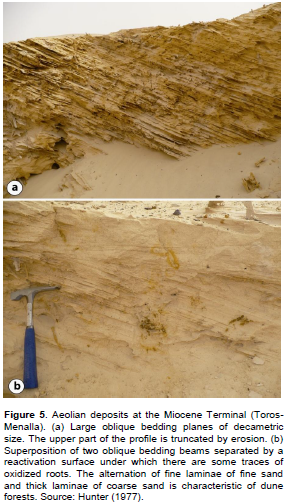
The root ducts which cross obliquely the bundles of oblique bedding appear only at the top of the profile. They are preserved in the form of solid or hollow tubes 5 to 50 cm in length, sometimes interrupted by oblique bedding. On large outcrops, the thickness of the oblique bedding bundles decreases upward. The total thickness of the sandy series is not known but probably exceeds 10 cm. The upper part of this sandy facies is systematically truncated by an erosion surface on which are deposited generally coarser sandy facies. Sometimes when the surfaces of the drills are preserved, wind ripples appear oriented perpendicular to the axis of progradation of the drills. These figures are exceedingly rare in the Aeolian fossil facies. At the fossiliferous sites of TM, the oblique megalitages at the top of the unit are truncated by erosion, showing convex oblique surfaces whose orientation indicates the direction of the paleovents at the time of their formation (Figures 6 and 8).

These sandy facies composed of fine to very fine sands, not at all cemented (all more recent sandy facies are) is mainly made up of many well-sorted, well-rounded, and non-micaceous quartz grains. For many authors, these are criteria that suggest a wind origin (Hunter, 1977, 1985; Swezey, 1998; Maithel et al., 2021). However, the most important criterion is the presence of an alternation of avalanche lamina (flow) and settling lamina (fall) of different particle size, in the oblique bedding (Figure 6). The presence of wind ripples perpendicular to the direction of progradation of the large oblique bedding on the ground confirms the development of aeolianpaleodunes (Figures 7 to 10). The drawing on the ground of the oblique megalitages of pluri-decametric and even hectometric scale also confirms the aeolian origin of this deposit. In addition, the total absence of any criterion typical of watercourses such as the presence of pebbles, soft pebbles, bedding of current ripples or waves, confirms the wind interpretation. This interpretation agrees with the first observations made by Schuster et al. (2006) and Moussa et al. (2016) which make it the oldest record of dunes in the region with an age reaching over 7 million years. These fossil dunes are therefore the oldest evidence of desert conditions in the Sahara (Schuster et al., 2006). Paleovent direction measurements (Vignaud et al., 2002; Schuster et al., 2006) on the oblique beds of the paleodunes indicate a direction of the winds generally oriented towards the South-West, that is, in the same direction as the current dunes of Djourab. The perfect superposition of the directions of the current prevailing winds (harmattan) and the wind of the Miocene is an interesting data for paleoclimatic reconstructions. The presence of a few root ducts (plants) and a few rare sandstone balls in the upper part of this facies testifies to the end of the desert period in favor of a more humid Sahelian-type climate. This essentially Aeolian sandy facies result mainly from an arid desert phase which ended a little before 7 Ma. The perfect superposition of the directions of the current prevailing winds (harmattan) and the winds of the Miocene is an interesting data for paleoclimatic reconstructions.



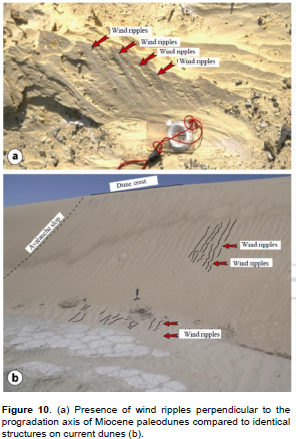
Root facies
The root facies is undoubtedly the most characteristic of the entire TM zone. It is the “flagship” facies of the Antrhacotheriid area. It is the one who delivered most of the vertebrate fossils, including Toumaï (Brunet et al., 2002; Bobe et al., 2020). This facies is characterized by an alternation of sandy levels and sandy-clay levels with roots and fossil termite nests of decimetric to pluri- decimetric scale (Figure 11). The sands between the rooted passes are often like the aeolian sands described earlier but in the absence of obvious sedimentary structures their interpretation remains uncertain if not that they seem genetically linked to the rooted horizons (Schuster et al., 2005). The transition between the two is also always diffuse and gradual, at least for the vertical passage “sand-paleosols” (Lemoalle et al., 2012). The bio-turbated part with roots is loosely cemented clay sandstone often greenish in color. This color is accentuated with the increase in the proportion of clay. This rooted facies is formed by a confused network of branched and bifurcated root conduits. The shape and size of the root ducts are very variable, but they are mostly circular in section and their diameter decreases from top to bottom of the profiles. The root ducts being slightly more cemented than the surrounding area, they appear in relief (Servant-Vildary, 1973). Some examples taken from the different TM sites show the passage between the rooted paleosol facies to the clay lacustrine facies (Figure 11). This passage is often clearly visible and underlined by an erosion surface (Figures 11 and 13). From a sequential point of view, the downward passage from greenish clayey sands with roots to light sands is always clear even if the very gradual decrease in the root network downwards sometimes gives the illusion of a continuous passage. Partly at the top, the passage from the horizon with roots to the overlying white sands can be erosive or very gradual.
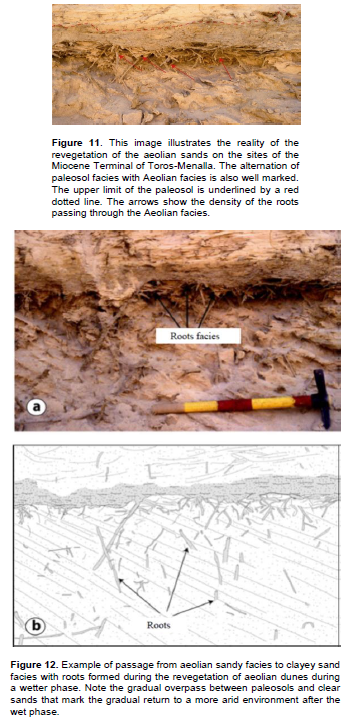
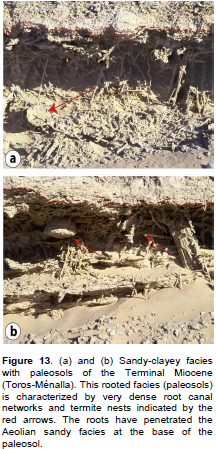
These rooted facies are the basic elementary motif which repeats itself vertically almost endlessly. It reflects the development and installation of a paleosol with roots on sands which could be wind turbines at least in part. Figure 11 is undoubtedly one of the most demonstrative examples. Dense, confused, and branched structures correspond well to root ducts and cannot be confused with burrows/galleries and/or other biological or sedimentary structures. Indeed, numerous indices/ recognition criteria make it possible to distinguish them from other structures. The ramifications and irregularities of shapes and diameters are very good criteria for recognizing root ducts (Plaziat, 1971). Figures 12 and 13 show the state of conservation of the exceptional ramifications of some of these root ducts.
These root facies are therefore interpreted as the revegetation of aeolian sands during wet phases which alternate with drier, Sahelian or totally desert phases.
The rhythmicity of the alternations is difficult to estimate because there is no significant difference in the age of the faunas collected from the base to the top of the Anthracotheriid Formation. In comparison with the climatic variations of the African Holocene, these cycles have at least 5,000 to 10,000 years, which would give, as first approximation, a range of 100,000 to 200,000 years at least for the whole unit to Anthracotheriid.
Sandstone facies with small oblique bedages
This sandstone facies are especially well developed in the upper part of the Anthracotheridae unit and particularly in contact with the major lacustrine series with which it is unmistakably linked (Figures 14 and 15). It is formed by a moderately to strongly cemented sandstone. The cementation is of clay and clay-diatomite origin (Schuster et al., 2005). The quartz grains, well sorted, are generally larger in size than in all the other facies (Ghienne et al., 2002; Moussa et al., 2016). These facies, unlike the sandy facies with oblique megalitages, is characterized by the development of small oblique bedding bundles of centimeter to pluricentimetric size. It is also characterized by the presence of current ripples, oscillation ripples and sometimes clay drapes (Figure 14). Oscillation megarids have been observed at certain sites, demonstrating the importance of lake or perilacustrine dynamics (Lemoalle et al., 2012; Maley and Maley 1981; Armitage et al., 2015). The abundance of clays in these facies is very variable, of the roots, and some levels are completely devoid of it. The base of this facies is still very clearly erosive on the underlying facies (Minisini et al., 2018).

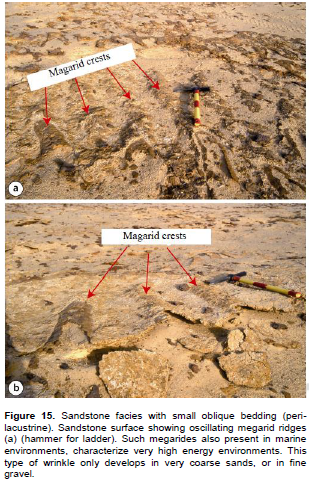
The appearance in these facies of current ripples and oscillation ripples, as well as clay drapes on the ripples, testifies for the first time with certainty of the immersion of the surface under a sheet of free water in motion (Olivry et al., 1996). Generally, placed at the top of the sequence of root paleosol facies, this facies undoubtedly marks the development of extensive flood zones.
It is typical transitional facies of the edge of a lake in which ripples and roots coexist for a certain time before giving way to the body of water (Lemoalle et al., 2012). Sometimes the sequences show a gradual passage between aeolian dunes, vegetated or not, and the lake, passing through phases with ripples and clay drapes (Pias, 1970). Such transgressive sequences are known in the Bol sector on the northern outskirts of present-day Lake Chad where the dunes are vegetated when the water level rises before being totally submerged (Leblanc et al., 2006; Moussa et al., 2016).
These facies are riddled with roots and bioturbations. It highlights the gradual installation of an undoubtedly perennial water body. The red dotted line indicates the limit between the two facies (Aeolian at the base and peri-lacustrine at the top).
This peri-lacustrine facies is the transition facies marking the flooding and progressive submersion of this sector during a phase of lacustrine transgression.
facies clayey, diatomite and clay-diatomite steels
Lacustrine sediments are characterized by two types of facies (Figures 16 and 17): clays and diatomites, and sometimes by a mixture of the two. This lacustrine facies almost always rests on an erosion surface (Figure 18). The clay or diatomaceous facies marks the end of the deposition sequence. It rests directly on the root facies (paleosols) or on the sandstone facies with small oblique bedages (peri-lacustrine) or, in certain sections, directly on the Aeolian formations of the base.

Clay facies
This lacustrine facies is formed of a more or less homogeneous green clay on the fossiliferous sites of TM (Figure 16a) never very thick with a few rare exceptions.
It often occurs as discontinuous lenses within sandstones and clayey sandstones. The diatomite/clay passage is not always clear and the transition is generally made by a mixture of the two facies. Diatomaceous earth becomes greener and greener when mixed with clay (Figure 17b). Very few sedimentary figures can be observed within these facies.
Diatomite facies
Diatomites appear as white spots that run the length of outcrops at the Toros-Menalla sites, especially on TM 254 where they form prominent outcrops, sometimes even small ledges in the landscape. The lacustrine diatomite facies is composed of pure white diatomites, or sometimes mixed with clays or/and silts which give them a gray tint (Figure 17). Diatomite is a rock very low density formed entirely or almost entirely of frustules of diatoms (unicellular algae with siliceous tests). Diatomites are often compact or finely bedded. Their thickness varies greatly depending on the outcrops, reaching up to a few centimeters. The lower contact with the underlying facies is still very clear. Diatomites are not very rich in vertebrate fossils, often limited to the remains of fish, turtles and crocodiles.

Even if diatoms abound in the marine environment, the development of substantial deposits is the exclusive fact of lake environments.
The diatomite facies and the clayey facies mark the installation of a perennial lacustrine environment during the Terminal Miocene on the fossiliferous sites of Toros-Ménalla. These clayey and diatomite facies correspond to transgressive lacustrine deposits (wet phases) which progress on the Aeolian facies (arid phases), the sandy-clay facies with paleosols and/or on the peri-lacustrine facies (Figure 18). These clayey and diatomite lacustrine facies can be compared with lake phases of the Mega-Chad type (Ghienne et al., 2002; Schuster, 2002; Schuster et al., 2003, 2005, 2009; Bouchette et al., 2010 ). Similar studies have shown relatively comparable sedimentary successions in the Mio-Pliocene age deposits of Chad (Duringer et al., 2000; Schuster, 2002; Bianchini et al., 2019). On some sections studied near Koro-Toro, Servant (1973) describes the installation of a transgressive lacustrine phase on aeolian deposits. The sedimentological characteristics of the lacustrine facies (clayey and diatomite) presented earlier allow us to precisely demonstrate the presence of a transgressive lacustrine phase in the fossiliferous sites of Toros- Menalla (TM).
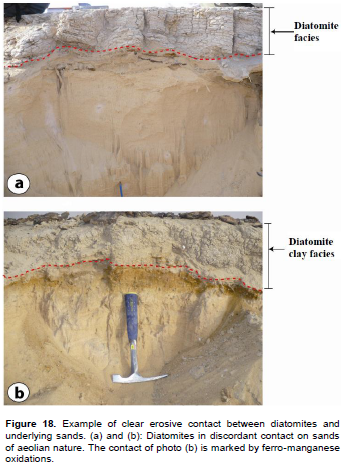
Typica deposit sequences
The composite section of TM 266 (Figure 19) shows the gradual passage of aeolian sands, to Sahelian, peri- lacustrine and then lacustrine sequences (Schuster et al., 2005). The ideal sequence drawn (Figures 19 and 20) traces the vertical evolution of the facies during this climatic drift (Lemoalle et al., 2012; Bristow et Armitage, 2016).
This standard sequence of the eolo-lacustrine series of the Terminal Miocene of the fossiliferous sites of Toros-Ménalla is characterized by the superposition of the four facies described previously with successively the Aeolian facies, the paleosol facies, the peri-lacustrine facies, and the lacustrine facies (Figure 19).

This "typical" sequence raised at the interface of two contrasting environments (desert at the base and lacustrine at the top) shows Aeolian facies covered by a paleosol (paleosol facies) with root ducts and bioconstructions of insects passing to sands: peri-lacustrine (peri-lacustrine facies) with small oblique beddings surmounted by diatomites or lacustrine clays (lacustrine facies) (Ghienne et al., 2002; Novello et al., 2017). Pattern variations within this “typical” sequence can be significant, such as being sometimes eroded, or even absent (Figure 20). Thus, clayey lacustrine facies can rest either directly on paleosols without an intermediate peri-lacustrine term, or directly on aeolian formations (Servant-Vildary, 1973). Fossil deposits are also often found with a transgressive base that allows a concentration of fossils (Brunet et al., 2002; Duval et al., 2021). The typical environments described in this sequence are therefore as follows:
(1) The basis of the sequence materializes a dry arid environment with the development of real dunes of large dimensions like those of ergs still exist today in the Djourab desert.
(2) The top of the sequence corresponds to a lake environment of the classic Mega Lake type.
(3) The middle part is literally a buffer zone between these two extreme environments. The transition to more humid climatic conditions will gradually vegetate the desert. During these "green phases", it allows the development of numerous paleosols. “Arid-humid” climatic fluctuations are at the origin of the alternation of sandy facies without structures (aeolian or Sahelian) with sandy-clay facies with paleosols.
(4) Near the lakes which are gradually spreading, peri-lacustrine facies is developing marked by the appearance of facies with current ripples and oscillation which gradually replaces the root facies of paleosols.
The first deposits correspond to a desert environment (Aeolian facies), gradually passing to lakeside deposits by a succession of paleosols (paleosol facies) increasingly marked by the increasing proximity of the lake (peri-lacustrine facies) and this sequence ends with the transgression of a perennial lake (lacustrine facies with diatomites and clays).
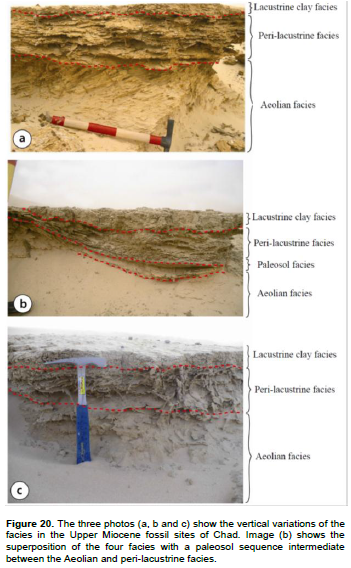
CONCLUSION
Based on the interpretation of the facies, the sedimentological study of the fossil Hominid sites of the late Miocene reveals four successive environments: the first deposits correspond to (1) an aeolian desert environment (aeolian facies), gradually passing to lakeside deposits by a succession (2) of paleosols (root facies or paleosols) increasingly marked by the increasing proximity (3) of the lake (peri-lacustrine facies). The sequence ends with the transgression (4) of a perennial lake (lacustrine facies with diatomites and clays). The fossiliferous facies (Anthracotheriid layers) set up between the two major Aeolian phases (at the base) and lacustrine (at the top), show an alternation of Sahelian phases episodically vegetated during wetter phases. The "dune-soils" sequence constitutes the recurring elementary motif of the deposit. From place to place, the insertion of clays or lacustrine diatomites manifests a transgressive pulsation with the installation of peri-lacustrine environments favoring the development of a more aquatic fauna. The installation of fauna clearly characterizes these “greener” phases.
By examining all the fossiliferous sites between 3 and 7 million years ago, we see that this northern part of the basin has almost always been a buffer zone oscillating according to climatic fluctuations between the lake, the edge of the lake, the Sahelian zone, and total desert. In this eolo-lacustrine transition zone, where the ancient hominids evolve, the lacustrine episodes are only temporary phases corresponding to the transgressions of the perennial central lake whose pulsations follow the climatic rhythm of the wet and dry phases. The Bol archipelago, located northeast of present-day Lake Chad, symbolizes an excellent model of this type of environment, where the lake and the desert merge.
CONFLICT OF INTERESTS
The authors have not declared any conflict of interests.
REFERENCES
|
Alemseged Z, Wynn JG, Geraads D, Reed D, Barr WA, Bobe R, McPherron SP (2020). Fossils from Mille-Logya, Afar, Ethiopia, elucidate the link between Pliocene environmental changes and Homo origins. Nature communications 11(1):1-12. |
|
|
Armitage SJ, Bristow CS, Drake NA (2015). West African monsoon dynamics inferred from abrupt fluctuations of Lake Mega-Chad. Proceedings of the National Academy of Sciences 112(28):8543-8548. |
|
|
Barboni D, Ashley GM, Bourel B, Arraiz H, Mazur JC (2019). Springs, palm groves, and the record of early hominins in Africa. Review of Palaeobotany and Palynology 266:23-41. |
|
|
Bianchini S, Solari L, Del Soldato M, Raspini F, Montalti R, Ciampalini A, Casagli N (2019). Ground subsidence susceptibility (GSS) mapping in Grosseto Plain (Tuscany, Italy) based on satellite InSAR data using frequency ratio and fuzzy logic. Remote Sensing 11(17):2015. |
|
|
Bobe R, Manthi FK, Ward CV, Plavcan JM, Carvalho S (2020). The ecology of Australopithecus anamensis in the early Pliocene of Kanapoi, Kenya. Journal of human evolution 140:102717. |
|
|
Bouchette F, Schuster M, Ghienne JF, Denamiel C, Roquin C, Moussa A, Duringer PH (2010). Hydrodynamics in the Holocene Lake Mega-Chad. Quaternary Research 73:226-236. |
|
|
Branco Pavanatto AE, Stock Da Rosa ÁA., Temp Müller R, Roberto Da Silva L, Ribeiro AM, Martinelli AG, Dias Da Silva S (2020). Bortolin site, a new fossiliferous locality in the Triassic (Ladinian/Carnian) of southern Brazil. Sociedade Brasileira de Paleontología. |
|
|
Bristow CS, Armitage SJ (2016). Dune ages in the sand deserts of the southern Sahara and Sahel. Quaternary International 410:46-57. |
|
|
Bristow CS, Holmes JA, Mattey D, Salzmann U, Sloane HJ (2018). A late Holocene palaeoenvironmental 'snapshot'of the Angamma Delta, Lake Megachad at the end of the African Humid Period. Quaternary Science Reviews 202:182-196. |
|
|
Brunet M, Beauvilain A, Coppens Y, Heintz E, Moutaye AHE, Pilbeam D (1995). The first australopithecine 2500 kilometres west of the Rift Valley (Chad). Nature 378:273-275. |
|
|
Brunet M, Beauvilain A, Coppens Y, Heintz E, Moutaye AHE (1996). Australopithecusbahrelghazali, une nouvelle espèce d'Hominidé ancien de la région de Koro Toro (Tchad). Comptes rendus de l'Académie des sciences. Série 2. Sciences De La Terre Et Des Planètes 322(10):907-913. |
|
|
Brunet M, Beauvilain A, Geraads D, Guy F, Kasser M, Mackaye HT, Mac Latchy LM, Mouchelin G, Sudre J, Vignaud P (1997). Tchad : un nouveau site à Hominidés pliocène. C. R. Acad. Sci. Paris 324:341-345. |
|
|
Brunet M, Guy F, Pilbeam D, Mackaye HT, Likius A, Ahounta D, Beauvilain A, Blondel C, Bocherens H, Boisserie JB, De Bonis L, Coppens C, Dejax J, Denys Ch, Duringer PH, Eisenmann V, Fanone G, Fronty P, Geraads D, Lehmann TH, Lihoreau F, Louchart A, Mahamat A, Merceron G, Mouchelin G, Otero O, PelaezCampomanes P, Ponce De Leon M, Rage JC, Sapanet M, Schuster M, Sudre J, Tassy P, Valentin X, Vignaud P, Viriot L, Zazzo A, Zollikofer CH (2002). A new hominid from the Miocene of Chad, central Africa..Nature 418(6894):145-151. |
|
|
Duringer P, Brunet M, Cambefort Y, Likius A, Mackaye HT, Schuster M, Vignaud P (2000). First discovery of fossil dung beetle brood balls and nests in the Chadian Pliocene Australopithecines levels. Lethaia 33(4):277-284. |
|
|
Duringer P, Schuster M, Genise JF, Mackaye HT, Vignaud P, Brunet M (2007). New termite trace fossils: Galleries, nests and fungus combs from the chad basin of Africa (Upper Miocene - Lower Pliocene). Palaeogeography Palaeoclimatology Palaeoecology 251(3-4):323-353. |
|
|
Duringer P, Schuster M, Genise JF, Likius A, Mackaye HT, Vignaud P, Brunet M (2006).The first fossil fungus gardens of Isoptera: oldest evidence of symbiotic termite fungiculture (Miocene, Chad basin). Naturwissenschaften 93(12):610-615. |
|
|
Duval M, Sahnouni M, Parés JM, van der Made, Abdessadok S, Harichane Z, Cheheb RC (2021). The Plio-Pleistocene sequence of Oued Boucherit (Algeria): A unique chronologically-constrained archaeological and palaeontological record in North Africa. Quaternary Science Reviews 271:107116. |
|
|
Ghienne JF, Schuster M, Bernard A, Duringer Ph, Brunet M (2002). The Holocene giant Lake Chad revealed by Digital Elevation Models. Quaternary International 87(1):81-85. |
|
|
Hunter RE (1977). Basic types of stratification in small eolian dunes. Journal of Sedimentary Petrology 24(3):361-387. |
|
|
Hunter RE (1985). Subaqueous sand-flow cross strata. Journal of Sedimentary Petrology 55(6):886-894. |
|
|
Lebatard AE, Bourlès D, Duringer P, Jolivet M, Braucher R, Carcaillet J, Schuster M, Arnaud N, Monié P, Lihoreau F, Likius A, Mackaye HT, Vignaud P, Brunet M (2008). Cosmogenic nuclide dating of Australopithecus bahrelghazali and Sahelanthropustchadensis: Mio-Pliocene Hominids from Chad. Proceedings of the National Academy of Sciences 105(9):3226-3231. |
|
|
Leblanc M, Favreau G, Maley J, Nazoumou Y, Leduc C, Stagnitti F, Oevelen PJ. van, Delclaux F, Lemoalle J (2006). Reconstruction of Megalake Chad using Shuttle Radar Topographic Mission data. Palaeogeogr. Palaeoclimatol. Palaeoecol 239(1-2):16-27. |
|
|
Lemoalle J, Bader JC, Leblanc M, Sedick A (2012). Recent changes in Lake Chad: Observations, simulations and management options (1973-2011). Global and Planetary Change 80:247-254. |
|
|
Mackaye HT (2001). Les proboscidiens du Miocène du Tchad : Biodiversité ; biochronologie ; paléoécologie ; et paléobiogéographie. Thèse de doctorat de l'Université de Poitiers (France) 209 p. |
|
|
Maithel SA, Brand LR, Whitmore JH (2021) Characterization of hard-to-differentiate dune stratification types in the Permian Coconino Sandstone (Arizona, USA). Sedimentology 68(1):238-265. |
|
|
Minisini D, Eldrett J, Bergman SC, Forkner R (2018). Chronostratigraphic framework and depositional environments in the organic-rich, mudstone-dominated Eagle Ford Group, Texas, USA. Sedimentology 65(5):1520-1557. |
|
|
Moussa A, Novello A, Lebatard AE, Decarreau A, Fontaine C, Barboni D, Sylvestre F (2016). Lake Chad sedimentation and environments during the late Miocene and Pliocene: New evidence from mineralogy and chemistry of the Bol core sediments. Journal of African Earth Sciences 118:192-204. |
|
|
Novello A, Barboni D, Sylvestre F, Lebatard AE, Pailles C, Bourles DL, Likius A (2017). Phytoliths indicate significant arboreal cover at Sahelanthropus type locality TM266 in northern Chad and a decrease in later sites. Journal of human evolution 106:66-83. |
|
|
Novello A, Lebatard AE, Moussa A, Barboni D, Sylvestre F, Bourlès DL, Paillès C (2015). Diatom, phytolith, and pollen records from a 10Be/9Be dated lacustrine succession in the Chad basin: insight on the Miocene-Pliocene paleoenvironmental changes in Central Africa. Palaeogeography, Palaeoclimatology, Palaeoecology 430:85-103. |
|
|
Olivry JC, Chouret A, Vuillaume G, Lemoalle J, Bricquet JP (1996). Hydrologie du lac Tchad (Vol. 12). |
|
|
Pias J (1970). La ve?ge?tation du Tchad: ses rapports avec les sols, variations pale?obotaniques au quaternaire; contribution a? la connaissance du bassin tchadien, Vol. 6. IRD Editions. |
|
|
Plaziat JC (1971). Racines ou terriers ? Critères de distinction à partir de quelques exemples du Tertiaire continental et littoral du bassin de Paris et du midi de la France. Conséquences paléogéographiques. Bulletin de la Société Géologique de France 7:1-2. |
|
|
Schneider JL, Wolf JP (1992). Carte ge?ologique et hydroge?ologique de 1/500 000 de la republique du Tchad, me?moire explicatif, 531. Paris: BRGM, P.531. |
|
|
Schuster M (2002). Sédimentologie et paléoécologie des séries à vertébrés du paléolac Tchad depuis le Miocène supérieur. Thèse de doctorat de l'Université Louis Pasteur, Strasbourg I. 152 p. |
|
|
Schuster M., Duringer Ph, Ghienne JF, Roquin C, Sepulchre P, Moussa A, Lebatard AE, Mackaye HT, Likius A, Vignaud P, Brunet M (2009). Chad Basin: paleoenvironments of the Sahara since the late Miocene. ComptesRendus Geosciences 341:612-620. |
|
|
Schuster M, Duringer Ph, Ghienne JF, Vignaud P, Beauvilain A, Mackaye HT, Brunet M (2003). Coastal conglomerate around the Hadjer el Khamisinselbergs (western Chad, central Africa): new evidence for Lake Mega-Chad episodes. Earth Surface Processes and Landforms 28(10):1059-1069. |
|
|
Schuster M, Duringer Ph, Ghienne JF, Vignaud P, Mackaye HT, Likius A, Brunet M (2006). The age of the Sahara Desert. Science 311:821. |
|
|
Schuster M, Roquin C, Duringer Ph, Brunet M, Fontugne M, Mackaye HT, Vignaud P, Ghienne JF (2005). Highlighting Holocene Lake Mega-Chad paleoshorelines from space. Quaternary Science Reviews 24(16-17):1821-1827. |
|
|
Servant-Vildary S (1973). Stratigraphie et néotectonique du Plio-Pléistocène ancien du Tchad d'après l'étude des Diatomites. C.R. Acad. Sc. Paris, t. 276 (9 mai 1973). Série D- 2633. |
|
|
Sewell L (2019) Using a multiproxy analysis of springbok fossils to track 2 million years of vegetation changes experienced by hominins in southern Africa. (PhD Thesis). Bournemouth University. |
|
|
Swezey C (1998). The identification of eolian sand and sandstones (L'identification des sables et gréséoliens. C.R. Acad. Sci. Paris, Sciences de la terre et des planètes / Earth and Planetary Sciences 327(8):513-518. |
|
|
Vignaud P, Duringer P, Mackaye HT, Likius A, Blondel C, Boisserie JR, De Bonis L, Eisenmann V, Etienne ME, Geraads D, Guy F (2002). Geology and palaeontology of the Upper Miocene Toros-Menalla hominid locality, Chad. Nature 418(6894):152-155. |
|
|
Warren A, Bristow C, Chappell A, Engelstaedter S, Mbainayel S, Todd M, Washington R (2005). The dustiest place and Earth. Nature 434:816-819. |
|
|
Yu Y, Kalashnikova OV, Garay MJ, Lee H, Notaro M, Campbell JR, Marquis J (2020. Disproving the Bodélé depression as the primary source of dust fertilizing the Amazon Rainforest. Geophysical Research Letters 47(13):e2020GL088020. |
|
Copyright © 2024 Author(s) retain the copyright of this article.
This article is published under the terms of the Creative Commons Attribution License 4.0